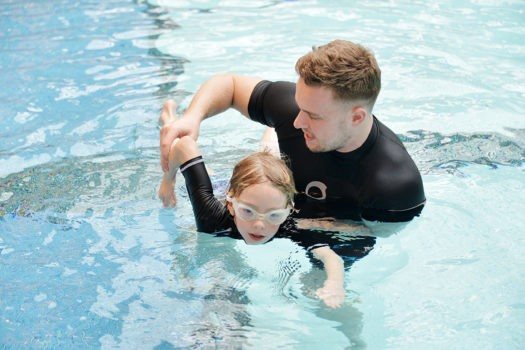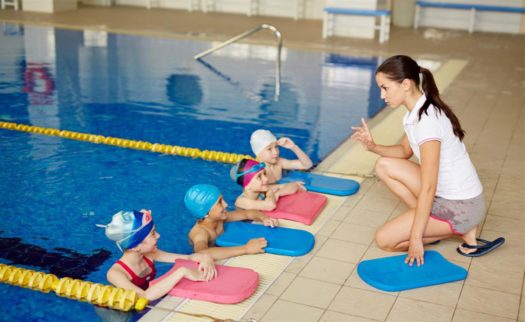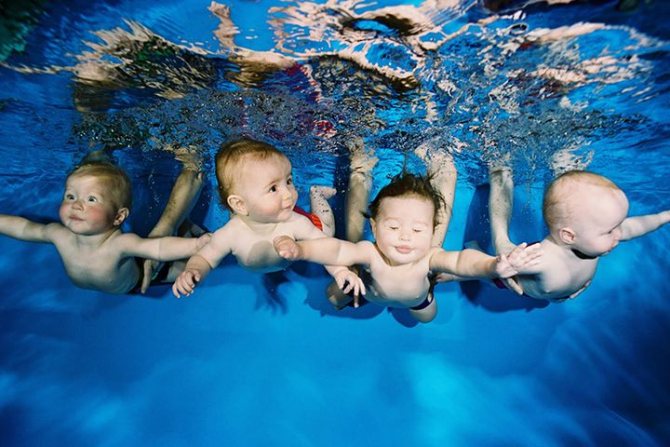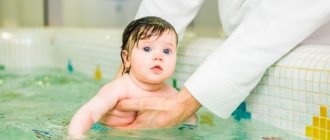Swimming lessons for children from 2 to 5 years old
Lessons in the pool for small children under 3 years old are always held individually. During such training, the child will be in constant contact with the instructor. With the help of such activities, it will be possible to accustom the child to being in the pool, since many children at this age, to varying degrees, are afraid of water. In the process of training, fears will pass and your health will significantly improve. It is worth remembering that classes, especially at such a young age, must be regular, since breaks of a month or more lead to an inevitable loss of skills. However, the child’s positive attitude towards water will already be formed, which is important in itself.
Most swimming coaches believe that a child should start playing this sport at an early age - from the age of three. At this time, the baby’s posture continues to develop and the pool will provide invaluable benefits to the spine. It is worth noting that the pool for children from 3 years old is only a pleasant pastime, since at this age it will not be possible to start swimming professionally. Since swimming is an intense sport, experts recommend attending training during this period no more than twice a week.
At this age, when playing in the pool, children use special sports equipment, which helps them better stay on the water and master basic skills.
Swim before walking: when to start your first lesson
It is necessary to bathe the baby immediately after discharge from the hospital. But it is better to postpone swimming lessons until the umbilical wound heals, usually no more than two weeks. A standard bathtub filled with water at 36-37°C is quite suitable for classes. Every week, reduce the water temperature by 0.5°C and stop at 28°C.
There is no need to make the water temperature higher than recommended. In warm water, the baby relaxes and does not want to actively move. The cooler the bath, the more intense the baby's movements will be.
Determine the time for classes in accordance with the child’s routine. Important:
- The baby should not be hungry, want to sleep, or be capricious. The most favorable period is 20–40 minutes after sleep and feeding.
- Don't plan your first swim for late evening. Some children get overexcited from intense movements, new emotions, and unfamiliar events, so they fall asleep restlessly and often wake up at night. Over time, you will learn when the best time to practice in your family is. The ideal time is a couple of feedings before bedtime.
- While bathing, keep the bathroom door open, do not create a sauna effect. The baby needs access to oxygen.
- Prepare in advance a towel, clean clothes, a diaper, baby cosmetics, a bedding for the baby, and formula (if the baby is bottle-fed). Perhaps the baby will get tired and immediately demand to eat or fall asleep.
- The amount of food for feeding after bathing should be larger (applies to bottle-fed babies), since during the lesson the baby spends up to 15 g of its own weight by burning fat.
- The duration of stay in the water should not exceed 10 minutes for the first swims and 30–45 minutes for an already swimming child. The time increases gradually, 3 minutes in each lesson.
- Be confident in your actions, avoid nervousness, don’t force things, add additional exercises, gradually increase the load. Overfatigue and fear of a child can permanently discourage him from even regular hygienic bathing.
- Focus on the child’s mood, condition, and his readiness to be in the water. It is strictly forbidden to work with a crying baby. The training will only be beneficial if the baby enjoys being in the water.
After birth, infants retain their breath-holding reflex for about two months, which later disappears. Therefore, start your first diving lessons as early as possible, without delaying until later.
While in the womb, the baby is surrounded by amniotic fluid. His innate swimming reflexes last up to 60 days. If you do everything correctly, your baby will be happy to take water treatments and will strengthen all the reflexes he needs: holding his breath, automatically walking, crawling.
Swimming lessons for preschool children from 5 years old
Swimming lessons for children 5 years and older will help raise a real champion, since it is at this age that children are accepted into professional sections. The child is now just beginning to understand that this is not just entertainment, but a serious sport. And if the child himself wants to engage in a sports section and participate in competitions, then it’s time to bring him to the pool. The number of lessons in the pool for children 5 years old should gradually increase from twice a week to five. In order for a young swimmer to be able to perform intense physical exercise, parents must understand that he must be provided with a nutritious, balanced diet.
5 years is the age when a child can also be sent to learn swimming from scratch. The swimming school provides classes both in a group (usually according to the level of training) and individual training. The child is under the constant supervision of a coach - small groups are formed so that all swimmers are given enough time and attention. Children who start learning to swim at this age quickly catch up with those who started learning at 2–3 years old.
Swimming lessons for children aged 7 to 9 years
Along with the first classes at a comprehensive school, a child can easily start swimming. Accordingly, from the second grade and older. At this time, he becomes more disciplined, which makes it easier for him to go to the pool. If you add effort to this quality, the child easily compares the coach’s tasks with the tasks of school teachers and quickly moves towards tangible results.
Additional equipment is usually not provided at this time, but everything depends on the child’s level of preparation and is decided individually by the coach.
The advantage of swimming in a pool from this age is that children begin to perceive information better. They can listen more carefully to the theoretical part of the classes, without being distracted from the instructor, which will improve both the quality of training and progression in learning.
Swimming pool for children from 9 to 12 years old
More professional training, which prepares young swimmers for sports competitions, begins on average at 9–12 years of age. The instructor complicates the teaching methods, developing the child's endurance and focusing on honing the techniques of swimming styles, which helps expand the young swimmer's theoretical knowledge along with skills in this sport.
To summarize, it is worth noting that you can start taking your child to the pool at different ages, depending on the wishes of the child and parents - just learn to swim and improve their health or start a sports career. Of course, the desire of the child himself is very important. A child’s desire to take up swimming can also be influenced by his coach, so choosing an instructor must be approached very carefully. When we love a teacher, then the children come to his classes with great pleasure. And this is a common success for the parents and the coach.
Infant swimming. Is it harmful?
It’s bad luck, we’ll start going to the pool in a week or two as the group forms, and then I came across an article about infant swimming and somehow I felt sick at the thought that I would take my baby into a large expanse of water. In general, who Don't be lazy, read it, what do you think about this?
“The early swimming technique is very common and recommended by doctors. Swimming pools for infants exist at clinics.
However, to date there is no statistical evidence that this actually improves children's health. There has been NO multivariate research on this issue.
The methodology itself comes from one, and purely speculative, premise. Since babies have a swimming reflex, which fades away by three months, since a liquid environment is a comfortable place for a newborn, and in general swimming is good gymnastics, you need to teach your child to swim (or even dive!) as early as possible.
It is impossible to find out from the baby himself how useful what is being done to him is for him, so supporters of early swimming try not to look especially at the child’s reaction, but look only at their theory.
How do babies react to swimming and diving? There are children who smile and even laugh during this procedure. There are children who scream and cry. The first type of reaction is automatically and, by the way, often mistakenly perceived by an adult as the baby’s approval of what is happening. The second type of reaction is not always alarming - young children generally cry a lot.
The reasoning on which the technique is based reveals a lack of information and a holistic vision of the situation. Unfortunately, this is not uncommon in our pediatrics.
Firstly, babies swim reflexively, that is, not like big children. All reflexes of newborns are so-called protective reflexes; they are saved for the first time for use in critical situations when it is necessary to save a life. For example, the grasping reflex is needed in order to grab onto something in emergency circumstances. The swimming reflex helps prevent choking for a few seconds until mom catches her from the water. By inducing or stimulating these reflexes, the mother puts the newborn (artificially) in a situation to save her life. By forcing the swimming reflex to work again and again by immersing the baby in water, we again and again create a stressful situation for the baby, a situation with emergency circumstances.
In addition, any physiologist will confirm that a reflex designed to fade away does not make sense to maintain artificially - it will fade away anyway. Any early swimming instructor will add that a baby’s swimming skills are lost as the reflex fades, and an older child still has to be taught again.
Secondly, stress is added by a large expanse of water. In the womb, the baby was also in a liquid environment, but there he did not breathe with his lungs. He was not faced with the vital task of keeping his body afloat in order not to suffocate: it was cramped there. A newborn baby is absolutely helpless in the face of depth. He is not yet able to comprehend the whole situation in its entirety, to predict that an adult will get him out of the water and prevent him from drowning. Under natural conditions, even swimming underwater, he will not be able to get ashore on his own and escape. Therefore, swimming and diving are perceived by the baby as dangerous to his life instinctively, automatically. He experiences the state of swimming, and even more so, diving, as an almost fatal condition.
Thirdly, a baby who is placed in conditions that support his full physical development simply does not need special gymnastics. And increased muscle load is unnatural for a child who cannot crawl. Data have already been accumulated on the negative consequences of dynamic gymnastics.
Therefore, it is better to leave sports until the time when the child can make it clear to his parents how much he likes what is being done to him.
Fourthly, today there is already evidence indicating that infant swimming often has a negative effect on the baby’s health.
Such exercises greatly increase the likelihood of otitis media, inflammation of the nasopharynx, colds and asthma attacks.
Pool water also enters the child's digestive system, which often leads to indigestion.
Swimming and diving of infants negatively affects the development of the vestibular apparatus. The constant impression of floating in space without support, which floating creates, distorts the ability to navigate in space, can completely eliminate the fear of heights, and increases the tendency to dizziness.
Swimming and diving can lead to breast refusal, poor weight gain and colic, as lactation consultants confirm.
Many doctors do not approve of diving due to the fact that they observe a worsening of the condition of the cervical spine, which has suffered a birth injury.
Pediatricians confirm that diving is harmful for children with increased intracranial pressure.
It is generally dangerous for an infant to dive until the bypass in the heart has completely healed, and this can only be diagnosed by a doctor after conducting appropriate studies.
In addition, resuscitators at the Filatov Children's Hospital (Moscow) talk about being forced to save the lives of a large number of infants who swallowed water while swimming.
Further. At first, it is always scary and unpleasant for a baby when he is bathed in a large volume of water. But what's around him? His mom or dad accompanies the bath with sounds of approval. They coo over him, smile at him, praise him, shake him with colorful toys, distracting him from the situation. Over time, the child ceases to accept a potentially dangerous situation as dangerous. The feeling of danger goes away. “My parents are happy to see me, they smile, and I will smile back at them, because I’m not afraid in the water, it’s good, it’s not dangerous.” In addition, this situation repeats itself constantly, it is inevitable, it cannot be avoided in any way. All that remains is to come to terms with it. Gradually, swimming becomes familiar and normal for the child. He stops feeling danger. And now there are already observations of children with whom they were actively involved in infant “diving”, and who, at the age of about a year, already clearly demonstrate a desire to swim and dive.
However, not all children find that swimming ceases to be stressful over time. Often there are children eager to swim who also exhibit hyperactivity and attacks of uncontrollable agitation. These attacks are well relieved by diving and swimming. Parents who are not familiar with the signs of such a phenomenon as addiction, in general, rejoice at the dynamism, strength and fearlessness of the baby. However, in such cases there is no need to talk about health. The fact is that frequent stress in infancy leads to a failure in the hormonal self-regulation of the body in children. In order to maintain chemical (and emotional) balance, in order to avoid overstimulation, the baby’s body begins to require situations that lead to an additional release of adrenaline into the blood. Growing up, such a person can maintain peace of mind only by experiencing stress from time to time. (Extreme sports for example)
The next observation about older infant swimmers is that such children consider themselves safe in any body of water, just as in the bath. But knowing how to swim does not exclude the possibility of drowning. In natural bodies of water, unlike bathtubs and pools, there are whirlpools, currents, underwater snags, etc.
And, of course, there are a large number of children who refuse to swim and dive after 8-12 months, when they finally have the opportunity to refuse.
And swimming pools for children are nothing more than a profitable business.”
From the article “Mistakes in raising infants”
3. A state of suppression of action, zombification, unhealthy self-absorption, complete indifference to the feelings and actions of others, the formation of a slave psychology and various complexes, sadomasochistic tendencies. These consequences lead to:
- winter swimming and dousing with cold water. In addition, winter swimming leads to disruptions in the functioning of the endocrine and cardiovascular systems, changes the attitude towards pain and leads to a lack of a sense of danger;
- diving and swimming of infants puts the child in a situation where he cannot resist the actions of an adult and, as it were, finds himself on the brink between life and death. This situation very often ends in overstress and deep depression for the child.
Let's look at the diving situation from the child's perspective. He came to new conditions of existence from a world where he was completely protected, provided with everything vital and protected from all troubles. His mother was the guarantor of such protection. The need for protection remains in the child throughout the entire period of brain development (3 years), i.e. he feels like an absolutely defenseless creature in need of care. And suddenly his mother gives him to someone else’s aunt (or better yet, she does it herself), who begins to drown him, putting him on the brink of life and death. The baby cannot understand your ideas about his development and health. He only understands that his life is in mortal danger. Moreover, this danger manifests itself regularly and has universal proportions, since the mother cannot protect him. The same applies to the hardening situation.
To better understand your child, imagine yourself in a similar situation. You lived happily in a palace where all your desires were fulfilled. And then one fine day you were invited to the sea coast and they started drowning you. How will you feel when you are suffocating and choking? It's a very unpleasant situation, isn't it? When you reach the shore, your royal dignity will be completely destroyed, and you will present a rather pitiful sight. Even your mature brain will suffer, so what can we say about a defenseless baby?
But besides this, diving has another unpleasant physiological aspect. Newborns have narrow and short nasal passages, which allows them to breathe shallowly. Thanks to this, a high level of carbon dioxide is maintained in the blood of babies in the first months of life. This mechanism helps the baby’s gentle adaptation to new conditions (in utero the fetus’s blood is venous, i.e. the oxygen content in it is reduced). Normal development of a baby's brain occurs under conditions of slightly reduced oxygen content in his blood. When diving, the level of oxygen necessary for brain development is significantly reduced and asphyxia occurs. Thus, diving carries two harmful factors - asphyxia and stress.
Among infant divers, the percentage of spontaneous infant mortality (death as a result of sudden cardiac arrest), aspiration pneumonia, and gastrointestinal disorders is very high.
Bathing itself is not harmful.
It is harmful to start it incorrectly and at the wrong time.
“You can be in a filled bathtub from 3 months old (with your mother), so with mom and dad in your arms and in the pool, you can go to the sea. The child will feel protected in his arms.
We recommend (usually) to bathe the baby in a small bath for up to 3 months. After three and up to six months, he bathes either in a small bath (adaptation) or in a large bath with mom (or dad, sister, brother). Mom is lying down, the baby is reclining on her chest. Maybe just lie down, maybe on his stomach, maybe suck his tit Wink. This way, organized bathing helps the child become familiar with support in the water. After all, as you all know, it is very important for a child to feel support in the water, and not weightlessness. This helps you feel confident in the water in the future. Well, then he sits in the bathtub, there are all sorts of ducks and fish, then he gets up. He walks and wanders, then he must start learning to dive."
https://www.darimmir.ru/azbuka_plavanie_grudnichkov
https://www.mosfamily.ru/articles/4_99
When should a child start swimming in the pool?
There are several age groups:
- Breast swimming. You can go swimming with your baby literally from the first days of life. There is a point of view that the sooner the better, before the baby has time to wean himself from his natural environment.
- After 2 years. 2-3 years is considered an excellent age for introducing a child to swimming in order to strengthen health, immunity and just for fun.
- After 5 years. At this age they begin to practice swimming professionally. So if you plan to make your child a champion, it is better to send your child to the pool at the age of 5-6 years.
What are the benefits of swimming for young children?
Infant swimming
Infant swimming can begin as soon as the baby’s umbilical cord heals, unless there are other contraindications. At the same time, it is not necessary to take your baby to specialized centers; you can swim in your home bath. For calmer swimming, you can purchase a special baby circle that fits around the neck.
Before you sign up for the pool with your baby, carefully study the conditions and collect information about the instructors. Please take into account certain inconveniences of visiting the pool in winter and consider your capabilities, since it will take a lot of time for the child to dry completely and travel.
Swimming at home is convenient because it can be organized at any time when the baby is in a good mood. You don’t have to worry about the purity of the water or possible drafts, and all the necessary care products are always at hand.
It is known that swimming at an early age does not in any way affect the child’s ability for this sport in the future. This is primarily a health and general development complex.
Swimming at 2-4 years old
As your child gets older, you can move on to conscious swimming. For children under four years old, you need to select a children's pool with the appropriate temperature and depth. Such pools can be located at children's hospitals and kindergartens. A qualified instructor must work with children.
If at this age you are sending your child to the pool for the first time, familiarize yourself with the technical characteristics of the pool. The pools can be 70-90 cm deep, which will allow the child not to be scared from the first training. At this age, children are already aware of the events around them, are impressionable and have a good memory. It is important to ensure that the child is comfortable from the very beginning.
Parents should not worry that at such a depth the child will not learn to float on the water, since he can freely reach the bottom with his feet. First of all, the instructor will teach you the correct movements of the arms and legs and breathing techniques. And the children will begin to swim without touching the bottom.
For classes, the instructor uses special boards and bolsters that keep the children afloat. The little ones are instructed to dive and get a coin or other small object from the bottom. A feature of this age is a possible fear of diving, so it is important to find an experienced and friendly trainer.
When moving to a deeper pool, children swim tied to a thread. The coach keeps control of the child’s movements, often without even plunging into the water with him.
Swimming for children over five years old
At this age we can already talk about the sports swimming section. And it doesn’t matter whether the child has practiced before: at both five and seven years old he will be able to develop professional swimming skills.
For older children, you need to choose a deeper pool. Any training will begin with the use of special equipment and under the supervision of an instructor, so parents should not worry.
The first few lessons should be taken individually; in the future, it is advisable to transfer the child to a group for greater interest and a competitive atmosphere.

Should I work out with a trainer or on my own?
Pool safety rules for children
- Teach children proper pool behavior from an early age. The child should wear non-slip shoes and not play around either in the water or on the shore. If your child often forgets to put on flip-flops when getting out of the water, purchase special cloth slippers for the pool. They do not slip on the floor and bottom of the pool and provide additional hygiene.
- It is necessary to dry your hair thoroughly before going outside to avoid hypothermia and wind.
- Teach caution. If the child is already an excellent swimmer, insist on using safety protection at sea and in other natural bodies of water. Children are not able to control themselves in emergency situations. An excellent swimmer, a arrogant child can swim far and throw off an inflatable ring. Never let your children out of your sight!
- Warn children that even for fun they should not jump into the water in ordinary clothes. There are known cases when people who knew how to swim drowned due to heavily weighted clothing.

Equipment for visiting the pool
Infant swimming: training or development
Experts say that it is not entirely true to say that infants are taught the basics of swimming. We are talking, rather, about one of the ways of development, about the opportunity to give the baby to feel free in any element, including water, which has already become close in 9 months in the mother’s belly.

There is no doubt that it is beneficial for a baby to flounder in water. Questions arise regarding the kind of swimming that is becoming fashionable now.
Where to begin?
The first bathing procedures are carried out at home; training should be carried out in a warm room. In the normal course of events, everything should go smoothly, since infants love to swim and bathe. Starting from the age of three months, the baby can be bathed in a large bathtub; for this, you can put a special bathing ring on his neck. This will greatly ease the condition of the mother or parent who will monitor the baby.
Children will not be able to swallow water; this device will not restrict their movements or cause discomfort, since the circle was invented solely for the convenience and safety of infants.

Parents should decide in advance what effect they want to achieve. After reaching the age of three months, the child and his parents can visit the water pool. Swimming with mom or dad will bring much more positive emotions. Not only the baby, but also his parents can spend time usefully. In order to properly accustom your child to this skill, you need to know some features of the process and the sequence of actions.
At the request of parents, children can study with a professional instructor who knows all the nuances in this matter; if it is not possible to regularly visit the pool or you do not trust such establishments, then an instructor can always be invited to your home. You can learn from him how to bathe a baby correctly, where to start, and what the nuances are.
Before diving into the water, it is advisable to give your baby a relaxing massage.
Many parents are interested in the question of when to start classes; the most optimal time is three months from the moment of birth. During this period, children still have the skill of holding their breath. Swimming for infants in the bath promotes their harmonious development appropriate for their age.








